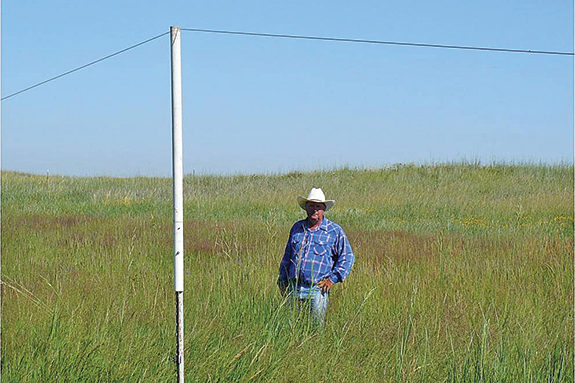Carr uses an intensive-grazing management style to give his land in Burwell, Nebraska, the maximum time to recover.
By decreasing paddock size and increasing stock density, most of his grazing land is recovering at any given time.
Carr currently keeps cattle between 250 and 300 head per herd and grazes them on one acre at a time. The herds may stay in one paddock from half a day to a week depending on the soil type and the health and number of plants.
While moving the cattle that frequently, Carr has picked up some tricks to make things easier. One idea he uses originated in Argentina. Instead of using gates, Carr uses two-inch PVC pipe to move from paddock to paddock. A notch is cut in the top and a hole drilled in the bottom.
When cattle need to be moved, the section of fence closest to them is simply lifted out of the way until they pass underneath. Carr said, “We don’t spend a lot of time moving cattle or driving cattle. We just go to the cattle and take them under the fence right where they are.”
As cattle are moved frequently and rotated through small paddocks, the rest of the ranch is recovering and growing. It is important to determine correctly when a paddock has had enough recovery time and is ready to be grazed again.
Carr said, “Before you come back and graze it again, the plants have to have three leaves fully extended; otherwise you will shrink the root system really badly.”
Keeping the root systems strong allows pastures to grow back stronger after being grazed, and over time the paddock productivity is increased.
Carr said, “Over a 10-year period, on some of those acres we’ve almost doubled the grazing on them. Not all of them, but some specific acres we’ve doubled the rate on it.”
Although increasing a pasture’s recovery time was one of the primary goals in using the rotational system, other benefits have resulted as well.
“There’s less time gathering cattle, checking cattle and doctoring cattle. Because we go out to move them, we can see 200 head in 10 minutes. If you had 200 head on a continuous five-month graze, it would maybe take you two, three hours to see all those cattle,” said Carr.
Carr also said that the cattle are healthier because they are constantly moving to fresh grass and fresh water.
In addition to these benefits, Carr has found that his management style is having a surprising ecological impact. Carr’s ranch is on a prairie chicken count route for the Fish and Game Service.
The birds, which are currently in the process of being added to the endangered species list, seem to like Carr’s grazing style, since he has a population 30 percent higher than any of his neighbors.
“The Fish and Game never did understand it, and I don’t understand it, but every year we increase that prairie chicken count route. That was a surprise to me,” said Carr.
Carr has spent years focusing on improving his grazing land through maximizing recovery time. His operation has seen many benefits from this emphasis; years have proven to him that it is worth the planning and adjustments.
“When you leave a paddock, it looks kind of beat up and you think, ‘That looks pretty tough.’ Then you go back and the plants are green
and lush and really growing, and that’s probably the best part of it for me.” FG
PHOTO
Using PVC pipe to raise the hot wire, Carr is able to move cattle between pastures without using gates. Photo courtesy of Jim Carr.












